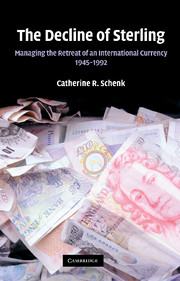Book contents
- Frontmatter
- Contents
- List of figures
- List of tables
- Acknowledgements
- 1 Introduction
- Part I Reconstructing the International Monetary System 1945–1959
- Part II Accelerating the Retreat: Sterling in the 1960s
- 4 Sterling and European integration
- 5 The 1967 sterling devaluation: relations with the United States and the IMF 1964–1969
- 6 Sterling and the City
- 7 Multilateral negotiations: sterling and the reform of the international monetary system
- 8 The Sterling Agreements of 1968
- Part III Sterling's Final Retreat 1970–1992
- Index
6 - Sterling and the City
Published online by Cambridge University Press: 04 May 2010
- Frontmatter
- Contents
- List of figures
- List of tables
- Acknowledgements
- 1 Introduction
- Part I Reconstructing the International Monetary System 1945–1959
- Part II Accelerating the Retreat: Sterling in the 1960s
- 4 Sterling and European integration
- 5 The 1967 sterling devaluation: relations with the United States and the IMF 1964–1969
- 6 Sterling and the City
- 7 Multilateral negotiations: sterling and the reform of the international monetary system
- 8 The Sterling Agreements of 1968
- Part III Sterling's Final Retreat 1970–1992
- Index
Summary
The empire may have disintegrated and the UK may now be a third-rate military power, but the City of London has staged a comeback which would be the envy of any child movie star reaching maturity.
I. O. Scott, quoted by R. J. Clark of Natwest in 1970Much of the criticism of the management of the retreat of sterling as an international currency has focused on a perceived contradiction between the City of London's financial interests in free trade and a strong and convertible pound as against the interests of industry in cheap money, a low exchange rate and protection. At the time of the post-war international monetary settlement, the interests of the City and the economy as a whole were usually seen as overlapping or even identical, particularly given the traumatic experience of British industry during the floating exchange rate era of the 1930s, when financial instability and disrupted trade patterns accentuated the impact of the depression on domestic producers. The traditional dependence of the balance of payments on invisible earnings was another key factor. In the planning for the post-war period, Keynes argued vehemently and persistently that the restoration of sterling as an internationally acceptable currency was a prerequisite to the re-establishment of the City of London as an international financial centre. Only if sterling were convertible would Commonwealth countries continue to bank in London. If sterling were not convertible then the sterling area arrangements would collapse, to the great detriment of both the British economy and the City of London.
- Type
- Chapter
- Information
- The Decline of SterlingManaging the Retreat of an International Currency, 1945–1992, pp. 206 - 240Publisher: Cambridge University PressPrint publication year: 2010



